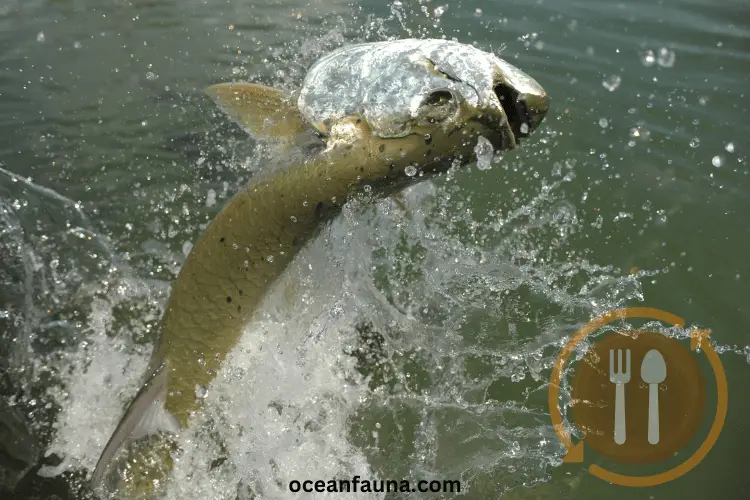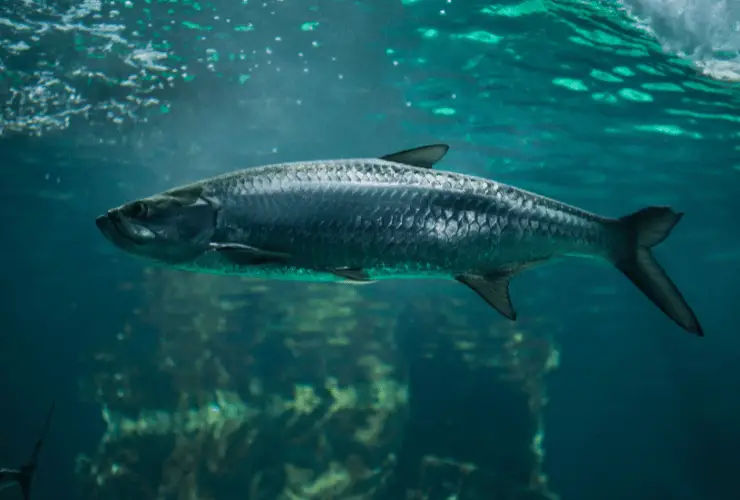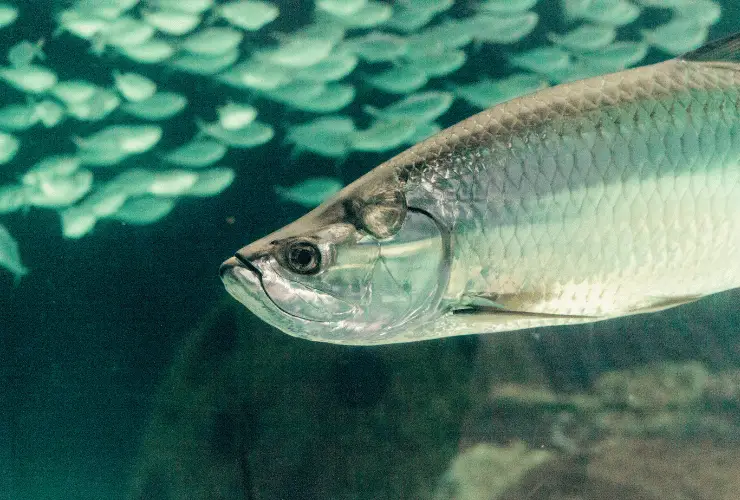Yes, you can consume tarpon as food. However, due to its size and tough, bony flesh, it is not considered a desirable or easy-to-cook fish for human consumption. In addition, the tarpon is often protected by catch-and-release regulations to ensure its survival and preservation as a species.
With its distinctive silvery scales and long, streamlined body, the tarpon is a highly prized catch for anglers. They are known as a popular target for sport fishing. Let’s learn more about how to eat a tarpon, how to cook a tarpon, and more!

What Is a Tarpon?
Tarpon is a large, migratory saltwater game fish. They are found in warm waters around the world.
The fish is characterized by its elongated and streamlined body, with a large, slightly upturned mouth and a single dorsal fin.
Tarpons have large, silver scales that reflect light. Also, they can grow to lengths of over 2.5m and weigh up to 161 kg.
Can You Eat Tarpon?
Yes, tarpon can technically be eaten, but it is not considered a desirable fish for human consumption due to its chewy texture and bony flesh. Thus, it’s not very easy to debone, which makes it an undesirable food option.
As a result, it is usually released back into the water to ensure its survival as a species or only fished for recreational purposes.
On the other hand, in some parts of the world, the tarpon is considered a delicacy and is prepared in a variety of ways, including grilling, baking, and frying.
In the Caribbean, the tarpon is occasionally consumed as food, and a few recipes call for fish. However, it is not a popular food item due to the difficulty of preparing and filleting the fish.
Eating Tarpon: Taste and Flavor
Do you know what does a Tarpon Taste Like? Tarpons are known for their fishy flavor and pungent odor.
This is why deboned tarpon meat is consumed in some countries as fishcakes because the seasoning hides this strong taste. The best part is that fishcakes minimize the chances of ingesting a tiny bone.
The taste of tarpon is often described as firm and meaty. It features a strong and distinct flavor that can vary depending on the region in which it was caught.
Some people describe the taste as similar to swordfish, while others say it has a flavor similar to beef or venison.
Thanks to the tarpon’s white flakey and oily skin, the fish has an exceptional texture. However, the final texture of cooked tarpon can also vary depending on how it is prepared.
When cooked properly, the flesh can be tender and moist, but it can also be tough and chewy if overcooked.
When cooking the tarpon, its bones can also be challenging for some people, as they are large and numerous, making the fish difficult to fillet. ~ AmericanOceans.org
Pros and Cons of Eating Tarpon

Pros
- Tarpon is a good source of protein.
- Tarpon is rich in nutrients such as omega-3 fatty acids known to minimize the risk of heart disease, stroke, and certain cancers. It is believed that consuming these nutrient-rich fish improves brain function. The fish also has anti-inflammatory properties.
- It can be a sustainable food source if harvested responsibly and within legal regulations.
- Catching and eating tarpon can be a unique and exciting experience for some anglers since the fish puts up a good fight during fishing.
- Tarpon is cheap and plentiful, especially in Panama and African countries.
Cons
- Because of the texture of tarpon meat, it can be extremely difficult to prepare and consume.
- The fish is not delectable because of the bony flesh and it doesn’t taste good.
- Tarpon is not a commonly consumed fish and may not be widely available.
- Consuming tarpon may contribute to overfishing and harm local ecosystems if not done responsibly.
- Tarpons may contain high levels of mercury, which can harm human health if consumed in large quantities.
Ways to Cook Tarpon
Cooking the tarpon can be a challenge, but if prepared with proper guidelines, one can prepare a flavorful, delectable dish.
One method is to marinate the fish in lime juice and spices for several hours before grilling or frying it. This can help soften the meat and add flavor to the fish.
Another option is to slow-cook the fish, either by baking it in the oven or cooking it in a pressure cooker. This will help break down the tough fibers of the fish and make it more tender.
Smoking the fish is also an option, which can add a distinct flavor to the meat.
Note: It’s important to take care when handling the fish and to use sharp knives to remove the bones.
Tarpon Fishcakes
Tarpon fishcakes are a delicious and unique way to enjoy the tarpon.
To make tarpon fishcakes, remove the bones and skin from the tarpon fillets and chop the meat into small pieces.
Mix the tarpon meat with mashed potatoes, chopped onions, garlic, and herbs such as parsley or cilantro.
Form the mixture into patties and coat them in breadcrumbs before frying them in oil until golden brown and crispy.
Poached Tarpon
Poached tarpon is a simple and healthy way to consume tarpon.
- To poach tarpon, start by bringing a pot of water to a simmer. Add a splash of white wine, some herbs such as thyme and bay leaves, and sliced lemon.
- Gently lower the tarpon fillets into the poaching liquid.
- Now, let them cook for 10-15 minutes or until the flesh is firm and opaque.
- Once the fish is cooked, you can serve it with various sides, such as steamed vegetables, rice, or crusty bread.
Tips and Warning for Cooking Tarpon

When it comes to preparing tarpon for eating, there are a few tips and warnings to keep in mind:
Handle the fish with caution
Be sure to handle the fish carefully because tarpon is difficult to fillet. Use a sharp knife and take your time to remove the bones and skin.
Source Tarpon from a reputable fishmonger
If you plan to cook tarpon, try to source it from a reputable fishmonger who can ensure it’s fresh and safe to eat.
Use slow-cook methods
Due to the tough texture of the flesh, the tarpon is best cooked using methods that can help to break down the fibers, such as slow cooking or poaching.
Marinate the fish
Marinating the fish in an acidic liquid such as lime juice or vinegar can help to soften the meat and add flavor.
Consume in moderation
Note: Be aware that tarpon may contain high levels of mercury.
Consume it in moderation and avoid it entirely if you are pregnant or have other health concerns.
What Is the Best Way to Cook and Debone a Tarpon?
- Preheat your oven to 350°F (175°C). Line a baking sheet with parchment paper or aluminum foil. Rinse the tarpon fillets under cold running water and pat them dry with paper towels.
- Rub the fillets with salt, pepper, and your preferred seasonings.
- Place the filets on the prepared baking sheet and bake them in the oven for 15-20 minutes or until the flesh is firm and opaque.
- Remove the fish from the oven and let it cool slightly. Use a sharp knife to remove the skin from each fillet carefully, then use the knife to cut out the bones gently.
Tip: Take your time and work carefully to avoid breaking the meat.
- Once the bones have been removed, the tarpon is ready to be served. You can pair it with various sides and sauces, such as roasted vegetables, rice, or a lemon butter sauce.
FAQs
What is the common name for tarpon?
The common name for tarpon is simply “tarpon.” At the same time, it is also known by other names in different regions, such as “sabalo” in Spanish-speaking countries and “grand Ecaille” in the French Caribbean.
Is it illegal to eat tarpon in Florida?
It is illegal to kill and keep tarpon in Florida, regardless of whether it is intended for consumption or sport fishing. Tarpons are a catch-and-release-only fish in Florida.
Can you eat tarpon in Australia?
It is legal to eat tarpon in Australia, but it is not a common practice as tarpon are primarily caught for sport fishing rather than for their meat.
What is the largest tarpon ever caught?
The largest tarpon ever caught on rod and reel weighed 283 pounds. It was caught off the coast of Guinea-Bissau in West Africa in 2003 by angler Max Domecq.
Conclusion
Tarpons can be cooked in various ways, including grilling, frying, and poaching. They are often used in dishes such as fishcakes and ceviche.
However, it is important to be aware of the potential risks associated with consuming tarpon, as it can contain high levels of mercury and other contaminants.
When cooking tarpon, it is also important to take care when deboning the fish to avoid any risk of injury. I hope this article clears up your confusion about eating and cooking tarpons.
